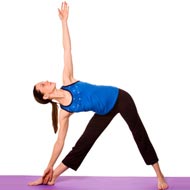- Aromatherapy (36)
- Benefits of Yoga (282)
- Home Remedies (1087)
- massage therapy (9)
- Preventive Therapy (135)
- Running (41)
- Skin Care (15)
- Stress Relief (25)
- Stretching (5)
- walking (33)
- Womens Health (14)
- Yoga Benefits for Pregnant Women (16)
- Yoga Benefits for Students (3)
- Yoga for Children (11)
- Yoga for Holistic Living (37)
- Yoga for Midlife Crisis (3)
- Yoga for Senior Citizens (2)
- Yoga for the Workplace (1)
- Yoga Health Tips (185)
- Yoga Practice during Menstruation (5)
How Does Yoga Help In Recovering from Slipped Disc Pain

A slipped disc is one of the commonest causes of pain in the lower back. The spinal core has flat, round, plate-like structures called disc. These lie between our vertebrae (back bones) and have a tough covering with a nucleus pulposus (a soft, gelatinous fluid) inside. The function of the disc is to cushion our vertebrae and let our backs flex. When the soft inside of a disk swells out, it puts pressure on the adjacent nerves in the spinal cord resulting in great pain and often debilitation. A slipped disc is usually known to occur in people between 20 and 50 year s of age. It is more common in men, particularly in people whose jobs call for lifting heavy objects, as well as in obese people.
Causes Of Slipped Disc
A slipped disc is normally caused by severe pressure on it, by the vertebrae over and beneath it. This is normally the result of lifting heavy objects in a bad posture or sudden jerks and twists. In many instances, weakening of a disk covering happens with age or due to a severe injury to the spine. Excess weight is also known to put pressure on disc, while smoking does contribute to their degeneration.
Symptoms
The most common symptom is severe pain in the region of the lower back. Pain normally spreads out from the region of the lower back, through your hips or buttocks down the back of your thigh to your knees; sometimes, all the way down to your foot. This is a sign of sciatica, the result of pressure on the sciatic nerve. Other symptoms of a slipped disc include numbness or tingling in the leg or loss of control over the bladder or bowel movements.
Yoga Therapy
General Guidelines
- Avoid bending forward more than 90 degrees so long as you have back pain
- Don’t do any forward bends, sitting or standing.
- Never arch your back.
- If you feel the slightest pain, tingling, numbness while doing an asana (posture) stop at once.
Asanas
- Start the session with Shavasana (Corpse Pose)
- Tadasana (Mountain Pose)
- Marichyasana III (Sage Marichi's Pose
- Bharadvajasana (Sage Bharadvaja Twist). Do this sitting on a chair
- Virabhadrasana II (Warrior II Pose. For this, take the support of a counter top or ledge and press your hands down it for support
- Utthita Parsvakonasana (Side Angle Pose)
- Utthita Trikonasana (Triangle Pose). Here too, use the support of a counter top or ledge, to support and lengthen your spine
- Ardha Urdhva Mukha Svanasana (Half Upward-Facing Dog Pose). Here, keep your hands on the back of a small stool or chair, never place them on the floor
- Supta Padangusthasana (Reclining Big Toe Pose). Use a belt around your, with knees bent at first
- Balasana (Child's Pose). Do this with your trunk supported on a bolster or a few folded Yoga blankets
- End the session with Shavasana (Corpse Pose)
Pranayama
- Mild Kapalabhati (Skull Cleansing)
- Anuloma-Viloma (Alternate Nostril Breathing)
Above all, have faith in your practices and never lose hope. Hundreds have recovered just by practicing Yoga regularly.
- RSS Feeds -
- All posts
- All comments
- Yoga Poses During Menstruation While yoga during menstruation is helpful, not all yoga exercises should be d...
- Walking Canes Walking canes are devices used to help in walking or ambulation. Walking cane...
- Supta Vajrasana For Digestion Supta Vajrasana in Sanskrit means thunderbolt, it was Lord Indra's weapon...
- Back Pain and Massage Therapy Back pain is one of the most common complaints in this day and age. Back pain...